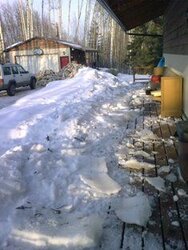- Dec 9, 2009
- 1,495
Decided I need to install another heat source in the house, and am going with a Toyo Laser 73. I have oil tanks behind garage, about 60-80' from where the stove will be installed. Had thought about moving a tank closer to the house, but this will be a major pain to do.
I think I can get by (at least for this winter) with running a fuel line over from the tank. My concern was that it might get stepped on by a moose and kinked or cut. I realized yesterday that I have two block walls that I could run it along, and they would shield almost all of the line, and I can a protect the small amout that is exposed by covering it with 2x6 or something similar.
However, I am concerned about the cold. I run #1 fuel in the tanks, and that will help. I thought about heat tape, not left running all the time, but just available to plug in short term if I should have a problem. However, I'm seeing that this is considered a bad idea. (My clue is the "Do not use on fuel lines" instruction they come with.)
I also saw that someone ran a hydraulic line and solve their icing problems that way. I don't know if they are formulated to stand up under that kind of use, or the expense involved.
I plan on insulating the line, but that will only help so much.
Winter is now here, the ground is frozen and we have snow. I want to come up with something that will get me through the winter. Next summer I can rethink this if necessary.
Your help with this is very much appreciated.
I think I can get by (at least for this winter) with running a fuel line over from the tank. My concern was that it might get stepped on by a moose and kinked or cut. I realized yesterday that I have two block walls that I could run it along, and they would shield almost all of the line, and I can a protect the small amout that is exposed by covering it with 2x6 or something similar.
However, I am concerned about the cold. I run #1 fuel in the tanks, and that will help. I thought about heat tape, not left running all the time, but just available to plug in short term if I should have a problem. However, I'm seeing that this is considered a bad idea. (My clue is the "Do not use on fuel lines" instruction they come with.)
I also saw that someone ran a hydraulic line and solve their icing problems that way. I don't know if they are formulated to stand up under that kind of use, or the expense involved.
I plan on insulating the line, but that will only help so much.
Winter is now here, the ground is frozen and we have snow. I want to come up with something that will get me through the winter. Next summer I can rethink this if necessary.
Your help with this is very much appreciated.




